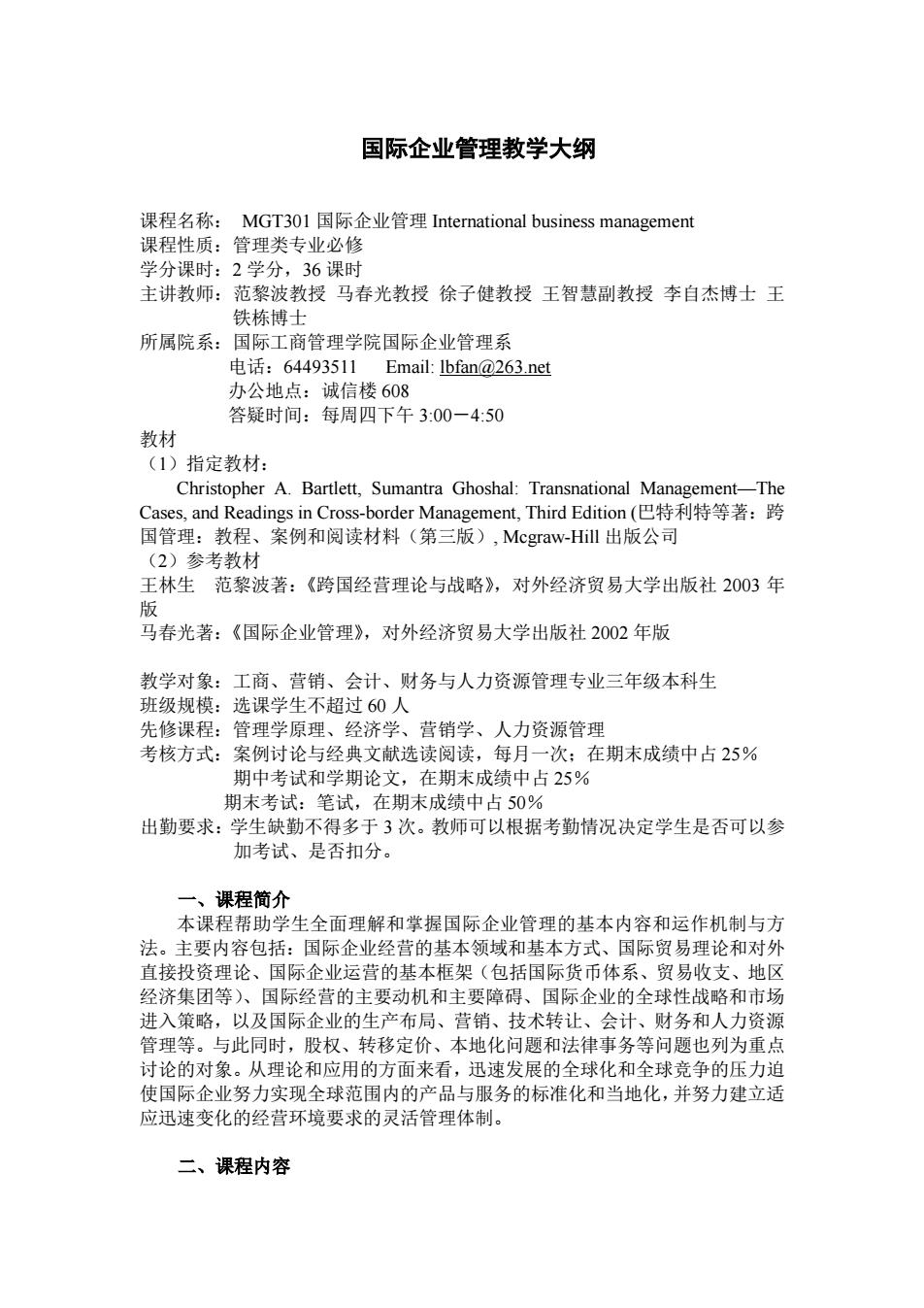
国际企业管理教学大纲 课程名称: MGT30l国际企业管理International business management 课程性质:管理类专业必修 学分课时:2学分,36课时 主讲教师:范黎波教授马春光教授徐子健教授王智慧副教授李自杰博士王 铁栋博士 所属院系:国际工商管理学院国际企业管理系 电话:64493511 Email:1bfan@263.net 办公地点:诚信楼608 答疑时间:每周四下午3:00一4:50 教材 (1)指定教材: Christopher A.Bartlett,Sumantra Ghoshal:Transnational Management-The Cases,and Readings in Cross--border Management,.Third Edition(巴特利特等著:跨 国管理:教程、案例和阅读材料(第三版),Mcgraw-Hill出版公司 (2)参考教材 王林生范黎波著:《跨国经营理论与战略》,对外经济贸易大学出版社2003年 版 马春光著:《国际企业管理》,对外经济贸易大学出版社2002年版 教学对象:工商、营销、会计、财务与人力资源管理专业三年级本科生 班级规模:选课学生不超过60人 先修课程:管理学原理、经济学、营销学、人力资源管理 考核方式:案例讨论与经典文献选读阅读,每月一次;在期末成绩中占25% 期中考试和学期论文,在期末成绩中占25% 期末考试:笔试,在期末成绩中占50% 出勤要求:学生缺勤不得多于3次。教师可以根据考勤情况决定学生是否可以参 加考试、是否扣分。 一、 课程简介 本课程帮助学生全面理解和掌握国际企业管理的基本内容和运作机制与方 法。主要内容包括:国际企业经营的基本领域和基本方式、国际贸易理论和对外 直接投资理论、国际企业运营的基本框架(包括国际货币体系、贸易收支、地区 经济集团等)、国际经营的主要动机和主要障碍、国际企业的全球性战略和市场 进入策略,以及国际企业的生产布局、营销、技术转让、会计、财务和人力资源 管理等。与此同时,股权、转移定价、本地化问题和法律事务等问题也列为重点 讨论的对象。从理论和应用的方面来看,迅速发展的全球化和全球竞争的压力迫 使国际企业努力实现全球范围内的产品与服务的标准化和当地化,并努力建立适 应迅速变化的经营环境要求的灵活管理体制。 二、课程内容
国际企业管理教学大纲 课程名称: MGT301 国际企业管理 International business management 课程性质:管理类专业必修 学分课时:2 学分,36 课时 主讲教师:范黎波教授 马春光教授 徐子健教授 王智慧副教授 李自杰博士 王 铁栋博士 所属院系:国际工商管理学院国际企业管理系 电话:64493511 Email: lbfan@263.net 办公地点:诚信楼 608 答疑时间:每周四下午 3:00-4:50 教材 (1)指定教材: Christopher A. Bartlett, Sumantra Ghoshal: Transnational Management—The Cases, and Readings in Cross-border Management, Third Edition (巴特利特等著:跨 国管理:教程、案例和阅读材料(第三版), Mcgraw-Hill 出版公司 (2)参考教材 王林生 范黎波著:《跨国经营理论与战略》,对外经济贸易大学出版社 2003 年 版 马春光著:《国际企业管理》,对外经济贸易大学出版社 2002 年版 教学对象:工商、营销、会计、财务与人力资源管理专业三年级本科生 班级规模:选课学生不超过 60 人 先修课程:管理学原理、经济学、营销学、人力资源管理 考核方式:案例讨论与经典文献选读阅读,每月一次;在期末成绩中占 25% 期中考试和学期论文,在期末成绩中占 25% 期末考试:笔试,在期末成绩中占 50% 出勤要求:学生缺勤不得多于 3 次。教师可以根据考勤情况决定学生是否可以参 加考试、是否扣分。 一、课程简介 本课程帮助学生全面理解和掌握国际企业管理的基本内容和运作机制与方 法。主要内容包括:国际企业经营的基本领域和基本方式、国际贸易理论和对外 直接投资理论、国际企业运营的基本框架(包括国际货币体系、贸易收支、地区 经济集团等)、国际经营的主要动机和主要障碍、国际企业的全球性战略和市场 进入策略,以及国际企业的生产布局、营销、技术转让、会计、财务和人力资源 管理等。与此同时,股权、转移定价、本地化问题和法律事务等问题也列为重点 讨论的对象。从理论和应用的方面来看,迅速发展的全球化和全球竞争的压力迫 使国际企业努力实现全球范围内的产品与服务的标准化和当地化,并努力建立适 应迅速变化的经营环境要求的灵活管理体制。 二、课程内容

第一章 导论 【教学目的和要求】 1、了解本课程的框架 教学时数:1 2、跨国公司的定义与概念发展教学时数:1 3、了解跨国公司所处的外部环境与面临的挑战 教学时数:1 【基础知识】 1、跨国公司定义 2、跨国经营的概念与发展 3、全球化的内涵 教学总时数:3 参考资料:《跨国经营理论与战略》第一章后参考文献 作业与练习:阅读《跨国管理》Readings1一l,1一2 案例讨论1:NGVARKAMPRAD AND IKEA 教学时数:2 Objectives The case contributes to learning at three broad levels: 1.The strategic level 2.The organizational level 3.The managerial level Subject and assignment questions 1.Subject:IKEA strategy in Sweden/Questions:What were the sources of IKEA's successful entry in furniture retailing business in Sweden? 2.Subject:IKEA's strategy while expanding internationally/Questions:How important was internationalization to IKEA?What challenges did IKEA face while expanding internationally,and how did it overcome them?3 Subject:Organizationa capabilities of IKEA/Questions:What were the management processes by which IKEA coordinated and controlled its Euro-wide operations?How effective were they? 4.Subject:Organizational value and Ingwar Kamprad's vision/Questions:What were Ingvar's role in IKEA's development? 5.Subject:Action plan for the future/Questions:What challenges lie ahead for IKEA? Please recommend what course of action Anders Moberg should follow in order to deal with them? 第二章 基于贸易的跨国经营理论 【教学目的和要求】 1、理解和掌握贸易结构优化理论教学时数:1 2、理解和掌握产品生命周期理论教学时数:0.5 3、理解和掌握边际产业理论 教学时数:0.5 4、理解和掌握国家竞争优势理论教学时数:1 【基础知识】 1、贸易结构优化理论
第一章 导论 【教学目的和要求】 1、了解本课程的框架 教学时数:1 2、跨国公司的定义与概念发展 教学时数:1 3、了解跨国公司所处的外部环境与面临的挑战 教学时数:1 【基础知识】 1、跨国公司定义 2、跨国经营的概念与发展 3、全球化的内涵 教学总时数:3 参考资料:《跨国经营理论与战略》第一章后参考文献 作业与练习:阅读《跨国管理》Readings 1-1,1-2 案例讨论 1:INGVARKAMPRAD AND IKEA 教学时数:2 Objectives·The case contributes to learning at three broad levels: 1. The strategic level 2. The organizational level 3. The managerial level Subject and assignment questions 1. Subject: IKEA strategy in Sweden/ Questions: What were the sources of IKEA’s successful entry in furniture retailing business in Sweden? 2.Subject: IKEA’s strategy while expanding internationally/ Questions: How important was internationalization to IKEA? What challenges did IKEA face while expanding internationally, and how did it overcome them? 3 Subject: Organizational capabilities of IKEA/ Questions: What were the management processes by which IKEA coordinated and controlled its Euro-wide operations? How effective were they? 4. Subject: Organizational value and Ingwar Kamprad’s vision/ Questions: What were Ingvar’s role in IKEA’s development? 5. Subject: Action plan for the future/ Questions: What challenges lie ahead for IKEA? Please recommend what course of action Anders Moberg should follow in order to deal with them? 第二章 基于贸易的跨国经营理论 【教学目的和要求】 1、理解和掌握贸易结构优化理论 教学时数:1 2、理解和掌握产品生命周期理论 教学时数:0.5 3、理解和掌握边际产业理论 教学时数:0.5 4、理解和掌握国家竞争优势理论 教学时数:1 【基础知识】 1、贸易结构优化理论
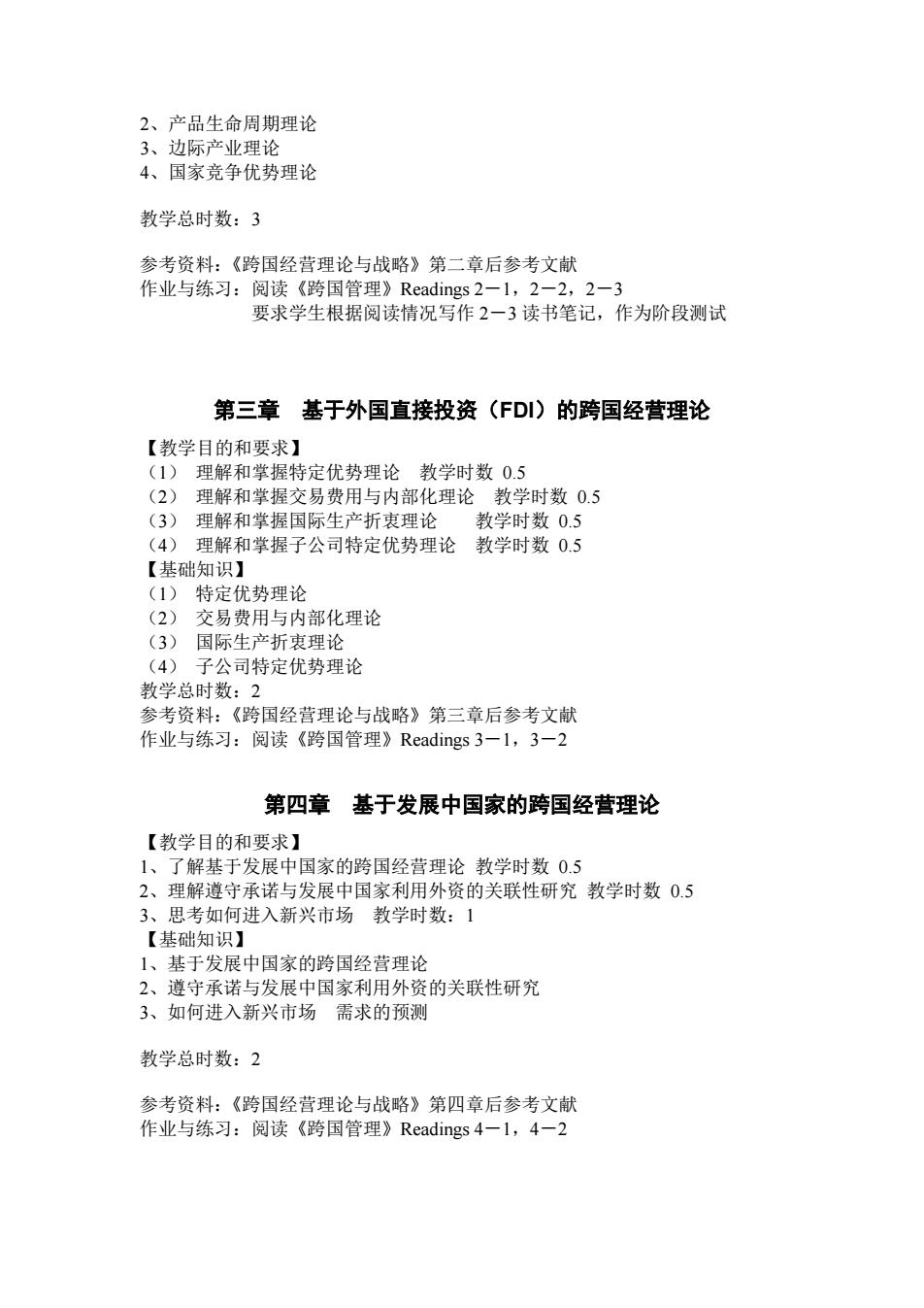
2、产品生命周期理论 3、边际产业理论 4、国家竞争优势理论 教学总时数:3 参考资料:《跨国经营理论与战略》第二章后参考文献 作业与练习:阅读《跨国管理》Readings2-1,2-2,2-3 要求学生根据阅读情况写作2一3读书笔记,作为阶段测试 第三章基于外国直接投资(FDI)的跨国经营理论 【教学目的和要求】 (1)理解和掌握特定优势理论教学时数0.5 (2)理解和掌握交易费用与内部化理论教学时数0.5 (3)理解和掌握国际生产折衷理论 教学时数0.5 (4)理解和掌握子公司特定优势理论教学时数0.5 【基础知识】 (1)特定优势理论 (2)交易费用与内部化理论 (3)国际生产折衷理论 (4)子公司特定优势理论 教学总时数:2 参考资料:《跨国经营理论与战略》第三章后参考文献 作业与练习:阅读《跨国管理》Readings3-l,3一2 第四章基于发展中国家的跨国经营理论 【教学目的和要求】 1、了解基于发展中国家的跨国经营理论教学时数0.5 2、理解遵守承诺与发展中国家利用外资的关联性研究教学时数0.5 3、思考如何进入新兴市场教学时数:1 【基础知识】 1、基于发展中国家的跨国经营理论 2、遵守承诺与发展中国家利用外资的关联性研究 3、如何进入新兴市场需求的预测 教学总时数:2 参考资料:《跨国经营理论与战略》第四章后参考文献 作业与练习:阅读《跨国管理》Readings4一1,4一2
2、产品生命周期理论 3、边际产业理论 4、国家竞争优势理论 教学总时数:3 参考资料:《跨国经营理论与战略》第二章后参考文献 作业与练习:阅读《跨国管理》Readings 2-1,2-2,2-3 要求学生根据阅读情况写作 2-3 读书笔记,作为阶段测试 第三章 基于外国直接投资(FDI)的跨国经营理论 【教学目的和要求】 (1) 理解和掌握特定优势理论 教学时数 0.5 (2) 理解和掌握交易费用与内部化理论 教学时数 0.5 (3) 理解和掌握国际生产折衷理论 教学时数 0.5 (4) 理解和掌握子公司特定优势理论 教学时数 0.5 【基础知识】 (1) 特定优势理论 (2) 交易费用与内部化理论 (3) 国际生产折衷理论 (4) 子公司特定优势理论 教学总时数:2 参考资料:《跨国经营理论与战略》第三章后参考文献 作业与练习:阅读《跨国管理》Readings 3-1,3-2 第四章 基于发展中国家的跨国经营理论 【教学目的和要求】 1、了解基于发展中国家的跨国经营理论 教学时数 0.5 2、理解遵守承诺与发展中国家利用外资的关联性研究 教学时数 0.5 3、思考如何进入新兴市场 教学时数:1 【基础知识】 1、基于发展中国家的跨国经营理论 2、遵守承诺与发展中国家利用外资的关联性研究 3、如何进入新兴市场 需求的预测 教学总时数:2 参考资料:《跨国经营理论与战略》第四章后参考文献 作业与练习:阅读《跨国管理》Readings 4-1,4-2
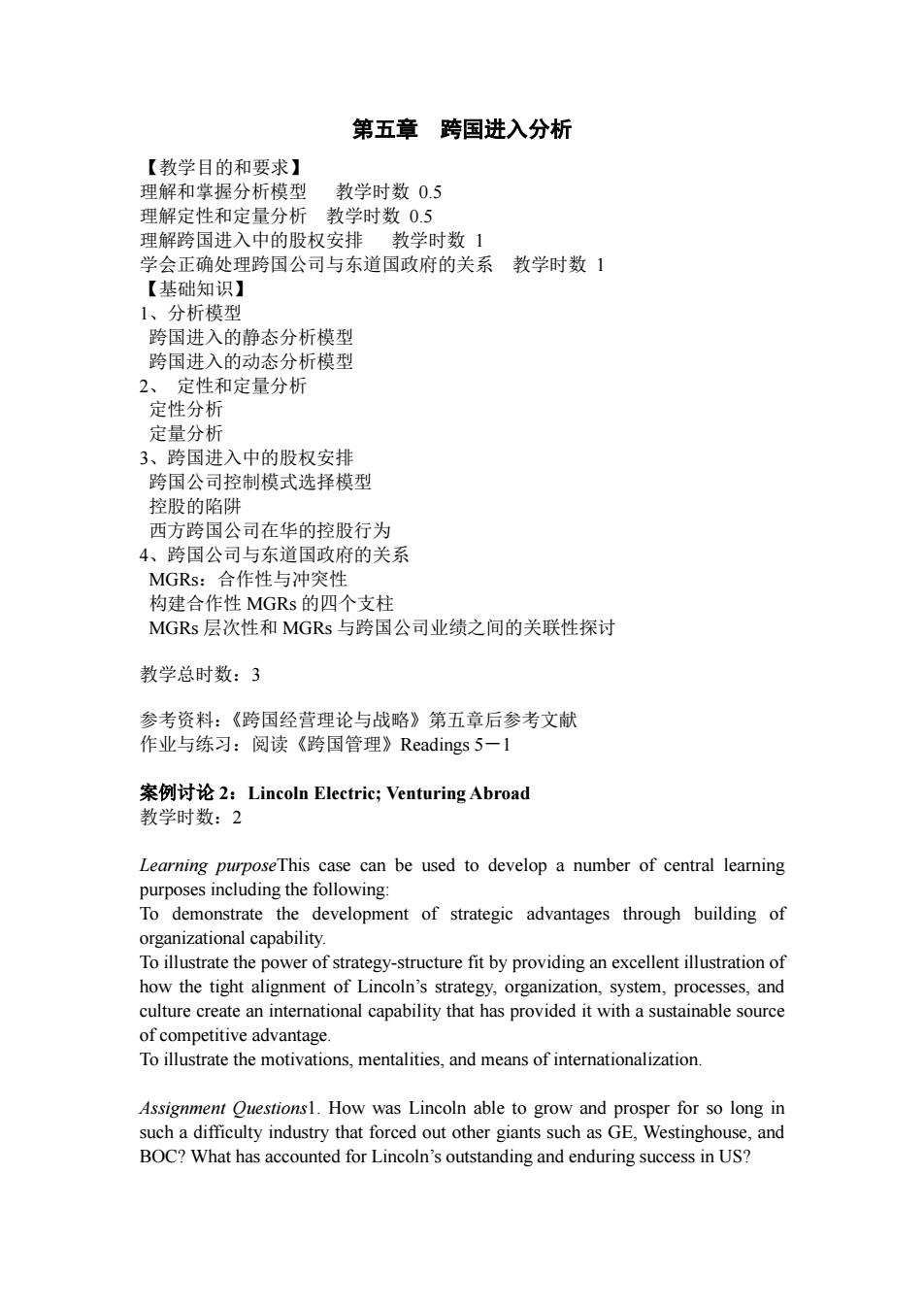
第五章 跨国进入分析 【教学目的和要求】 理解和掌握分析模型 教学时数0.5 理解定性和定量分析教学时数0.5 理解跨国进入中的股权安排教学时数1 学会正确处理跨国公司与东道国政府的关系教学时数1 【基础知识】 1、分析模型 跨国进入的静态分析模型 跨国进入的动态分析模型 2、定性和定量分析 定性分析 定量分析 3、跨国进入中的股权安排 跨国公司控制模式选择模型 控股的陷阱 西方跨国公司在华的控股行为 4、跨国公司与东道国政府的关系 MGRs:合作性与冲突性 构建合作性MGRs的四个支柱 MGRs层次性和MGRs与跨国公司业绩之间的关联性探讨 教学总时数:3 参考资料:《跨国经营理论与战略》第五章后参考文献 作业与练习:阅读《跨国管理》Readings5一1 案例讨论2:Lincoln Electric;Venturing Abroad 教学时数:2 Learning purposeThis case can be used to develop a number of central learning purposes including the following: To demonstrate the development of strategic advantages through building of organizational capability. To illustrate the power of strategy-structure fit by providing an excellent illustration of how the tight alignment of Lincoln's strategy,organization,system,processes,and culture create an international capability that has provided it with a sustainable source of competitive advantage. To illustrate the motivations,mentalities,and means of internationalization Assignment Questions1.How was Lincoln able to grow and prosper for so long in such a difficulty industry that forced out other giants such as GE,Westinghouse,and BOC?What has accounted for Lincoln's outstanding and enduring success in US?
第五章 跨国进入分析 【教学目的和要求】 理解和掌握分析模型 教学时数 0.5 理解定性和定量分析 教学时数 0.5 理解跨国进入中的股权安排 教学时数 1 学会正确处理跨国公司与东道国政府的关系 教学时数 1 【基础知识】 1、分析模型 跨国进入的静态分析模型 跨国进入的动态分析模型 2、 定性和定量分析 定性分析 定量分析 3、跨国进入中的股权安排 跨国公司控制模式选择模型 控股的陷阱 西方跨国公司在华的控股行为 4、跨国公司与东道国政府的关系 MGRs:合作性与冲突性 构建合作性 MGRs 的四个支柱 MGRs 层次性和 MGRs 与跨国公司业绩之间的关联性探讨 教学总时数:3 参考资料:《跨国经营理论与战略》第五章后参考文献 作业与练习:阅读《跨国管理》Readings 5-1 案例讨论 2:Lincoln Electric; Venturing Abroad 教学时数:2 Learning purposeThis case can be used to develop a number of central learning purposes including the following: To demonstrate the development of strategic advantages through building of organizational capability. To illustrate the power of strategy-structure fit by providing an excellent illustration of how the tight alignment of Lincoln’s strategy, organization, system, processes, and culture create an international capability that has provided it with a sustainable source of competitive advantage. To illustrate the motivations, mentalities, and means of internationalization. Assignment Questions1. How was Lincoln able to grow and prosper for so long in such a difficulty industry that forced out other giants such as GE, Westinghouse, and BOC? What has accounted for Lincoln’s outstanding and enduring success in US?
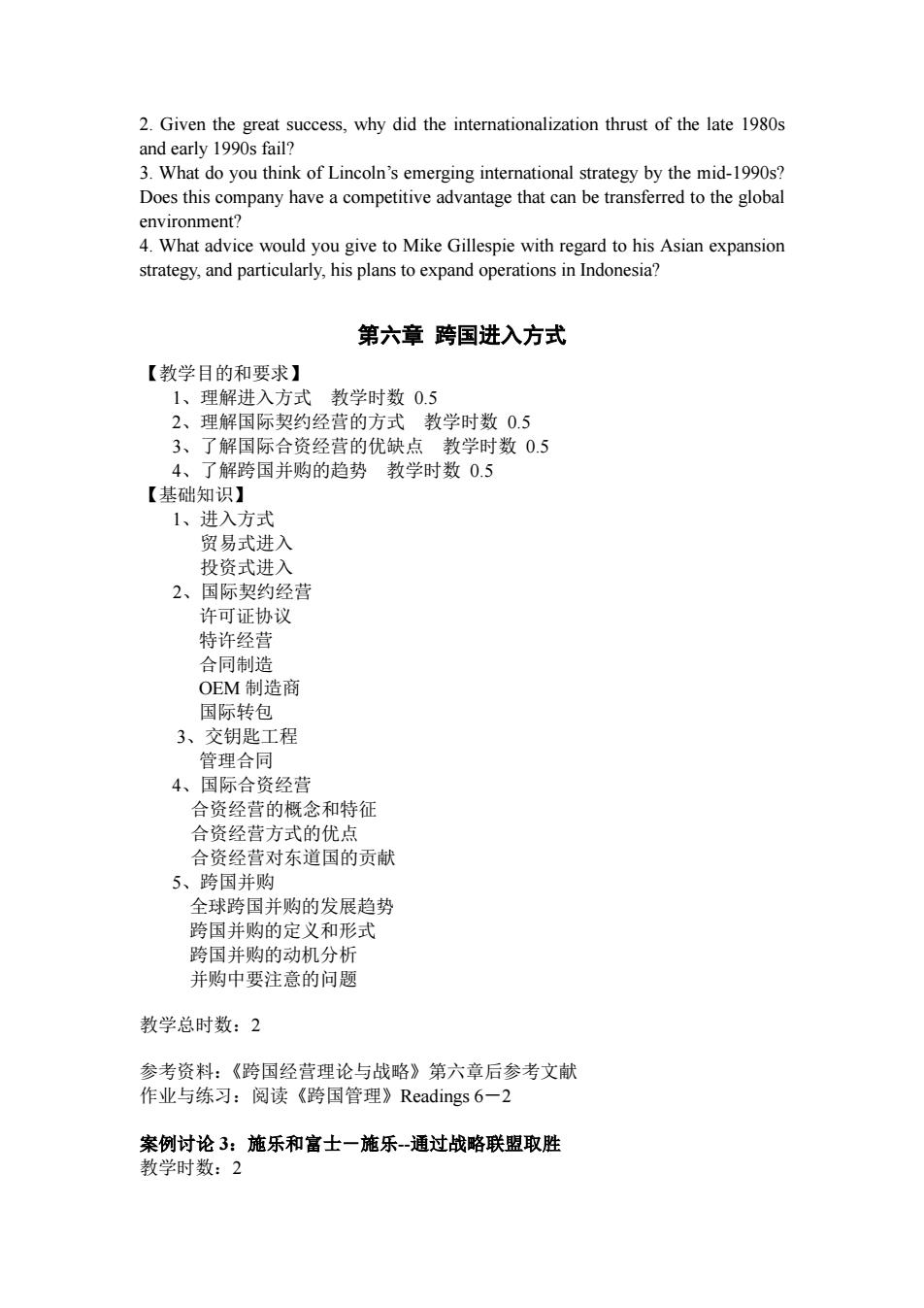
2.Given the great success,why did the internationalization thrust of the late 1980s and early 1990s fail? 3.What do you think of Lincoln's emerging international strategy by the mid-1990s? Does this company have a competitive advantage that can be transferred to the global environment? 4.What advice would you give to Mike Gillespie with regard to his Asian expansion strategy,and particularly,his plans to expand operations in Indonesia? 第六章跨国进入方式 【教学目的和要求】 1、理解进入方式教学时数0.5 2、理解国际契约经营的方式教学时数0.5 3、了解国际合资经营的优缺点教学时数0.5 4、了解跨国并购的趋势教学时数0.5 【基础知识】 1、进入方式 贸易式进入 投资式进入 2、国际契约经营 许可证协议 特许经营 合同制造 OEM制造商 国际转包 3、交钥匙工程 管理合同 4、国际合资经营 合资经营的概念和特征 合资经营方式的优点 合资经营对东道国的贡献 5、跨国并购 全球跨国并购的发展趋势 跨国并购的定义和形式 跨国并购的动机分析 并购中要注意的问题 教学总时数:2 参考资料:《跨国经营理论与战略》第六章后参考文献 作业与练习:阅读《跨国管理》Readings6一2 案例讨论3:施乐和富士一施乐-通过战略联盟取胜 教学时数:2
2. Given the great success, why did the internationalization thrust of the late 1980s and early 1990s fail? 3. What do you think of Lincoln’s emerging international strategy by the mid-1990s? Does this company have a competitive advantage that can be transferred to the global environment? 4. What advice would you give to Mike Gillespie with regard to his Asian expansion strategy, and particularly, his plans to expand operations in Indonesia? 第六章 跨国进入方式 【教学目的和要求】 1、理解进入方式 教学时数 0.5 2、理解国际契约经营的方式 教学时数 0.5 3、了解国际合资经营的优缺点 教学时数 0.5 4、了解跨国并购的趋势 教学时数 0.5 【基础知识】 1、进入方式 贸易式进入 投资式进入 2、国际契约经营 许可证协议 特许经营 合同制造 OEM 制造商 国际转包 3、交钥匙工程 管理合同 4、国际合资经营 合资经营的概念和特征 合资经营方式的优点 合资经营对东道国的贡献 5、跨国并购 全球跨国并购的发展趋势 跨国并购的定义和形式 跨国并购的动机分析 并购中要注意的问题 教学总时数:2 参考资料:《跨国经营理论与战略》第六章后参考文献 作业与练习:阅读《跨国管理》Readings 6-2 案例讨论 3:施乐和富士-施乐--通过战略联盟取胜 教学时数:2

Learning objectivesThis case is about managing strategic alliances,even though the case is about equity joint venture,it illustrates issues in the management of other types of alliances too.Firstly,we should pay more attention on dynamics of international alliances.These include: how partners learn through alliances, How alliances grew and develop,and how the relationship between partners evolves in response to external and internal changes. Second,appropriate measures of alliance performance and underlying success factors may change dramatically over the life of an alliance. Third,there Is often a serious tradeoff between giving local autonomy to an alliance and integrating into a parent's global strategy. Fourth,the structure and substance of collaboration needs to change in response to change in the external environment and in the capabilities and goals of the partners. Final,different sets of factors drive collaboration in marketing,research,and manufacturing,even though the success of collaboration in one functional area often depends on that in another. Analysis and Discussion Structure 1.Performance of the alliance before 1990 2.Future options for collaboration 3.Globalization and Organizational Structure 4.Conclusion 第七章获得全球竞争优势 【教学目的和要求】 1、了解全球运营与价值创造的方式教学时数:0.5 2、学会运用获得全球竞争优势结构设计的方法教学时数:1 3、了解管理全球价值链教学时数:0.5 4、理解竞争性企业战略教学时数:0.5 5、掌握跨国企业的竞争模式教学时数:0.5 【基础知识】 1、 全球运营与价值创造 应当地市场 寻求全球的规模经济性 开发全球的范围经济性 为价值活动和资源配置选择最佳的区位 跨地区的知识转移最大化 2、 获得全球竞争优势结构设计 设计最优的网络结构 建立世界一流的地区竞争力 确保无磨擦的合作 3、 管理全球价值链
Learning objectivesThis case is about managing strategic alliances, even though the case is about equity joint venture, it illustrates issues in the management of other types of alliances too.Firstly, we should pay more attention on dynamics of international alliances. These include: how partners learn through alliances, How alliances grew and develop, and how the relationship between partners evolves in response to external and internal changes. Second, appropriate measures of alliance performance and underlying success factors may change dramatically over the life of an alliance. Third, there Is often a serious tradeoff between giving local autonomy to an alliance and integrating into a parent’s global strategy. Fourth, the structure and substance of collaboration needs to change in response to change in the external environment and in the capabilities and goals of the partners. Final, different sets of factors drive collaboration in marketing, research, and manufacturing, even though the success of collaboration in one functional area often depends on that in another. Analysis and Discussion Structure 1. Performance of the alliance before 1990 2. Future options for collaboration 3. Globalization and Organizational Structure 4. Conclusion 第七章 获得全球竞争优势 【教学目的和要求】 1、了解全球运营与价值创造的方式 教学时数:0.5 2、学会运用获得全球竞争优势结构设计的方法 教学时数:1 3、了解管理全球价值链 教学时数:0.5 4、理解竞争性企业战略 教学时数:0.5 5、掌握跨国企业的竞争模式 教学时数:0.5 【基础知识】 1、 全球运营与价值创造 应当地市场 寻求全球的规模经济性 开发全球的范围经济性 为价值活动和资源配置选择最佳的区位 跨地区的知识转移最大化 2、 获得全球竞争优势结构设计 设计最优的网络结构 建立世界一流的地区竞争力 确保无磨擦的合作 3、 管理全球价值链
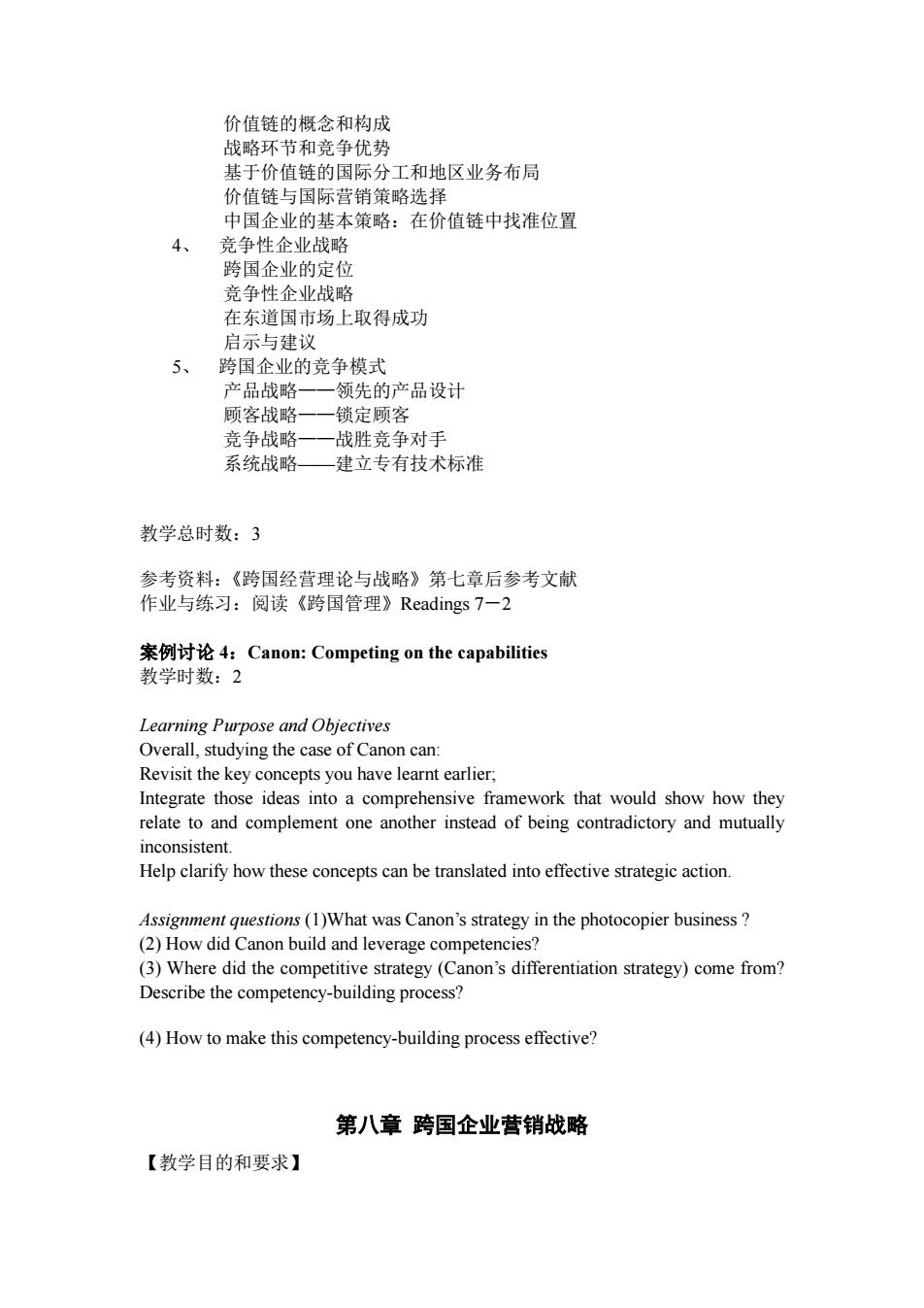
价值链的概念和构成 战略环节和竞争优势 基于价值链的国际分工和地区业务布局 价值链与国际营销策略选择 中国企业的基本策略:在价值链中找准位置 4、 竞争性企业战略 跨国企业的定位 竞争性企业战略 在东道国市场上取得成功 启示与建议 5、 跨国企业的竞争模式 产品战略 领先的产品设计 顾客战略 锁定顾客 竞争战略一一战胜竞争对手 系统战略 建立专有技术标准 教学总时数:3 参考资料:《跨国经营理论与战略》第七章后参考文献 作业与练习:阅读《跨国管理》Readings7一2 案例讨论4:Canon:Competing on the capabilities 教学时数:2 Learning Purpose and Objectives Overall,studying the case of Canon can: Revisit the key concepts you have learnt earlier; Integrate those ideas into a comprehensive framework that would show how they relate to and complement one another instead of being contradictory and mutually inconsistent. Help clarify how these concepts can be translated into effective strategic action. Assignment questions(1)What was Canon's strategy in the photocopier business (2)How did Canon build and leverage competencies? (3)Where did the competitive strategy(Canon's differentiation strategy)come from? Describe the competency-building process? (4)How to make this competency-building process effective? 第八章跨国企业营销战略 【教学目的和要求】
价值链的概念和构成 战略环节和竞争优势 基于价值链的国际分工和地区业务布局 价值链与国际营销策略选择 中国企业的基本策略:在价值链中找准位置 4、 竞争性企业战略 跨国企业的定位 竞争性企业战略 在东道国市场上取得成功 启示与建议 5、 跨国企业的竞争模式 产品战略——领先的产品设计 顾客战略——锁定顾客 竞争战略——战胜竞争对手 系统战略——建立专有技术标准 教学总时数:3 参考资料:《跨国经营理论与战略》第七章后参考文献 作业与练习:阅读《跨国管理》Readings 7-2 案例讨论 4:Canon: Competing on the capabilities 教学时数:2 Learning Purpose and Objectives Overall, studying the case of Canon can: Revisit the key concepts you have learnt earlier; Integrate those ideas into a comprehensive framework that would show how they relate to and complement one another instead of being contradictory and mutually inconsistent. Help clarify how these concepts can be translated into effective strategic action. Assignment questions (1)What was Canon’s strategy in the photocopier business ? (2) How did Canon build and leverage competencies? (3) Where did the competitive strategy (Canon’s differentiation strategy) come from? Describe the competency-building process? (4) How to make this competency-building process effective? 第八章 跨国企业营销战略 【教学目的和要求】

1、了解国际营销渠道理管的基本方式。教学时数:0.5 2、了解国际产品策略教学时数:0.5 3、学习并掌握目标市场营销模式教学时数:0.5 4、了解产品定价策略和品牌战略教学时数:0.5 【基础知识】 1、国际营销渠道管理 分销渠道 一个典型的分销体系 分销策略 2、国际产品策略 关于国际性产品的特性研究 国际产品策略 3、目标市场营销 目标市场营销 变换营销组合 4、产品定价策略 价格策略 跨国企业总部管理人员的统一协调 5、品牌战略 品牌与品牌的价值 品牌战略的实施 宝洁公司的市场研究和品牌管理对我们的启示 教学总时数:2.5 参考资料:《跨国经营理论与战略》第八章后参考文献 作业与练习:阅读《跨国管理》Readings8-l 案例讨论5:Caterpillar Tractor 教学时数:2 Learning Purpose and objectives The first is to focus on the way in which forces of change can transform an industry structure and thus the competitive characteristics in a global environment The second is to identify the sources of Caterpillar's extraordinary competition domination of this industry. he third is related to the issue of strategic fit.This case provides an ideal example of a company whose strategic posture has been designed to fit external industry demands and market needs.Furthermore,this external fit is reinforced by an internal fit in which the various functional elements support the overall strategic objectives. Ouestions1.What are the major changes in EME Industry? 2.What are the key elements in Caterpillar's strategy?How has this strategy helped Cat to deal with the highly cyclical industry? 3.As a member of Lee Morgan's management team,what recommendations would
1、了解国际营销渠道理管的基本方式。教学时数:0.5 2、了解国际产品策略 教学时数:0.5 3、学习并掌握目标市场营销模式 教学时数:0.5 4、了解产品定价策略和品牌战略 教学时数:0.5 【基础知识】 1、 国际营销渠道管理 分销渠道 一个典型的分销体系 分销策略 2、 国际产品策略 关于国际性产品的特性研究 国际产品策略 3、 目标市场营销 目标市场营销 变换营销组合 4、 产品定价策略 价格策略 跨国企业总部管理人员的统一协调 5、 品牌战略 品牌与品牌的价值 品牌战略的实施 宝洁公司的市场研究和品牌管理对我们的启示 教学总时数:2.5 参考资料:《跨国经营理论与战略》第八章后参考文献 作业与练习:阅读《跨国管理》Readings 8-1 案例讨论 5:Caterpillar Tractor 教学时数:2 Learning Purpose and objectives The first is to focus on the way in which forces of change can transform an industry structure and thus the competitive characteristics in a global environment. The second is to identify the sources of Caterpillar’s extraordinary competition domination of this industry. The third is related to the issue of strategic fit. This case provides an ideal example of a company whose strategic posture has been designed to fit external industry demands and market needs. Furthermore, this external fit is reinforced by an internal fit in which the various functional elements support the overall strategic objectives. Questions1. What are the major changes in EME Industry? 2. What are the key elements in Caterpillar’s strategy? How has this strategy helped Cat to deal with the highly cyclical industry? 3. As a member of Lee Morgan’s management team, what recommendations would
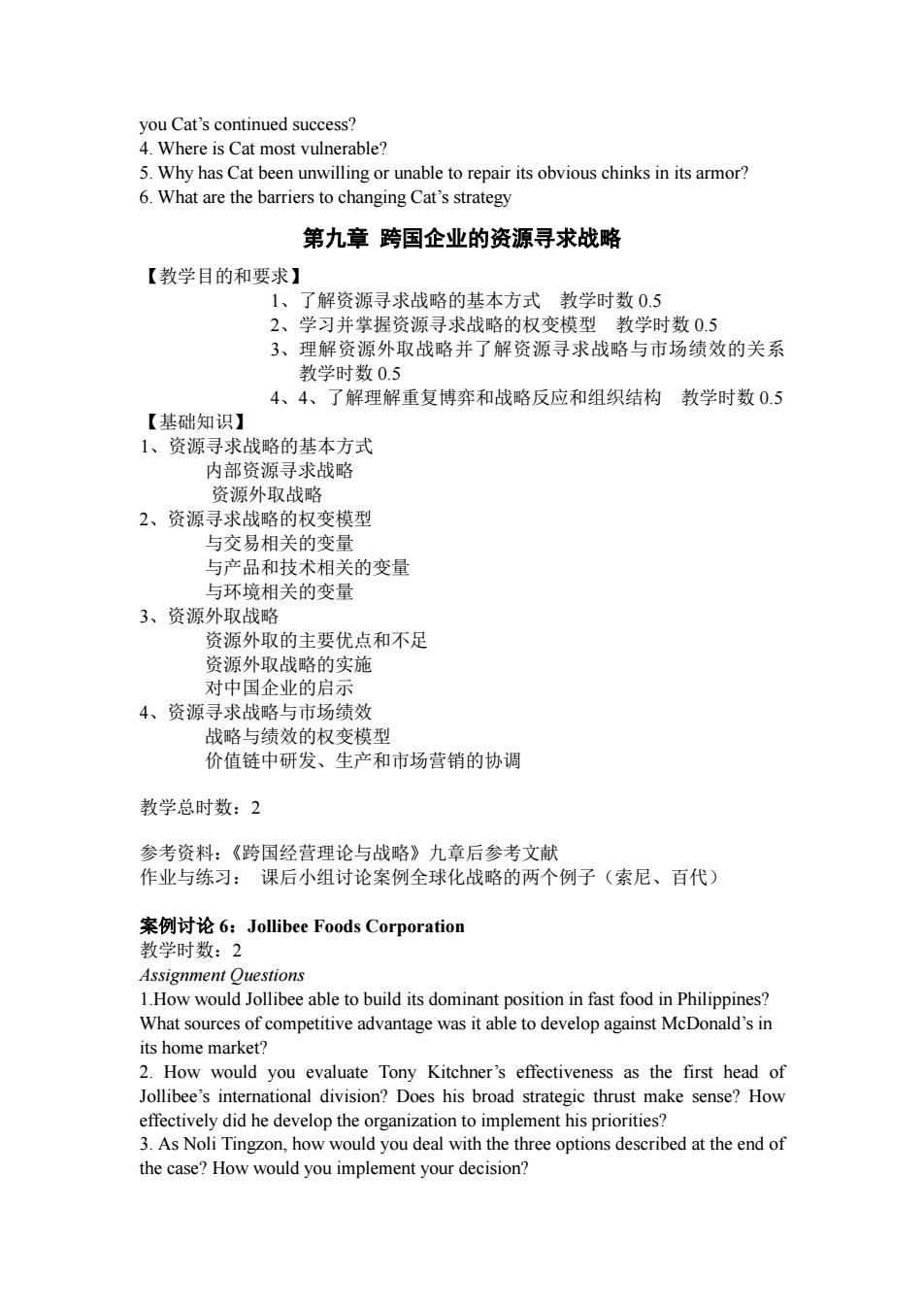
you Cat's continued success? 4.Where is Cat most vulnerable? 5.Why has Cat been unwilling or unable to repair its obvious chinks in its armor? 6.What are the barriers to changing Cat's strategy 第九章跨国企业的资源寻求战略 【教学目的和要求】 1、了解资源寻求战略的基本方式教学时数0.5 2、学习并掌握资源寻求战略的权变模型教学时数0.5 3、理解资源外取战略并了解资源寻求战略与市场绩效的关系 教学时数0.5 4、4、了解理解重复博弈和战略反应和组织结构教学时数0.5 【基础知识】 1、资源寻求战略的基本方式 内部资源寻求战略 资源外取战略 2、资源寻求战略的权变模型 与交易相关的变量 与产品和技术相关的变量 与环境相关的变量 3、资源外取战略 资源外取的主要优点和不足 资源外取战略的实施 对中国企业的启示 4、资源寻求战略与市场绩效 战略与绩效的权变模型 价值链中研发、生产和市场营销的协调 教学总时数:2 参考资料:《跨国经营理论与战略》九章后参考文献 作业与练习:课后小组讨论案例全球化战略的两个例子(索尼、百代) 案例讨论6:Jollibee Foods Corporation 教学时数:2 Assignment Ouestions 1.How would Jollibee able to build its dominant position in fast food in Philippines? What sources of competitive advantage was it able to develop against McDonald's in its home market? 2.How would you evaluate Tony Kitchner's effectiveness as the first head of Jollibee's international division?Does his broad strategic thrust make sense?How effectively did he develop the organization to implement his priorities? 3.As Noli Tingzon,how would you deal with the three options described at the end of the case?How would you implement your decision?
you Cat’s continued success? 4. Where is Cat most vulnerable? 5. Why has Cat been unwilling or unable to repair its obvious chinks in its armor? 6. What are the barriers to changing Cat’s strategy 第九章 跨国企业的资源寻求战略 【教学目的和要求】 1、了解资源寻求战略的基本方式 教学时数 0.5 2、学习并掌握资源寻求战略的权变模型 教学时数 0.5 3、理解资源外取战略并了解资源寻求战略与市场绩效的关系 教学时数 0.5 4、4、了解理解重复博弈和战略反应和组织结构 教学时数 0.5 【基础知识】 1、资源寻求战略的基本方式 内部资源寻求战略 资源外取战略 2、资源寻求战略的权变模型 与交易相关的变量 与产品和技术相关的变量 与环境相关的变量 3、资源外取战略 资源外取的主要优点和不足 资源外取战略的实施 对中国企业的启示 4、资源寻求战略与市场绩效 战略与绩效的权变模型 价值链中研发、生产和市场营销的协调 教学总时数:2 参考资料:《跨国经营理论与战略》九章后参考文献 作业与练习: 课后小组讨论案例全球化战略的两个例子(索尼、百代) 案例讨论 6:Jollibee Foods Corporation 教学时数:2 Assignment Questions 1.How would Jollibee able to build its dominant position in fast food in Philippines? What sources of competitive advantage was it able to develop against McDonald’s in its home market? 2. How would you evaluate Tony Kitchner’s effectiveness as the first head of Jollibee’s international division? Does his broad strategic thrust make sense? How effectively did he develop the organization to implement his priorities? 3. As Noli Tingzon, how would you deal with the three options described at the end of the case? How would you implement your decision?
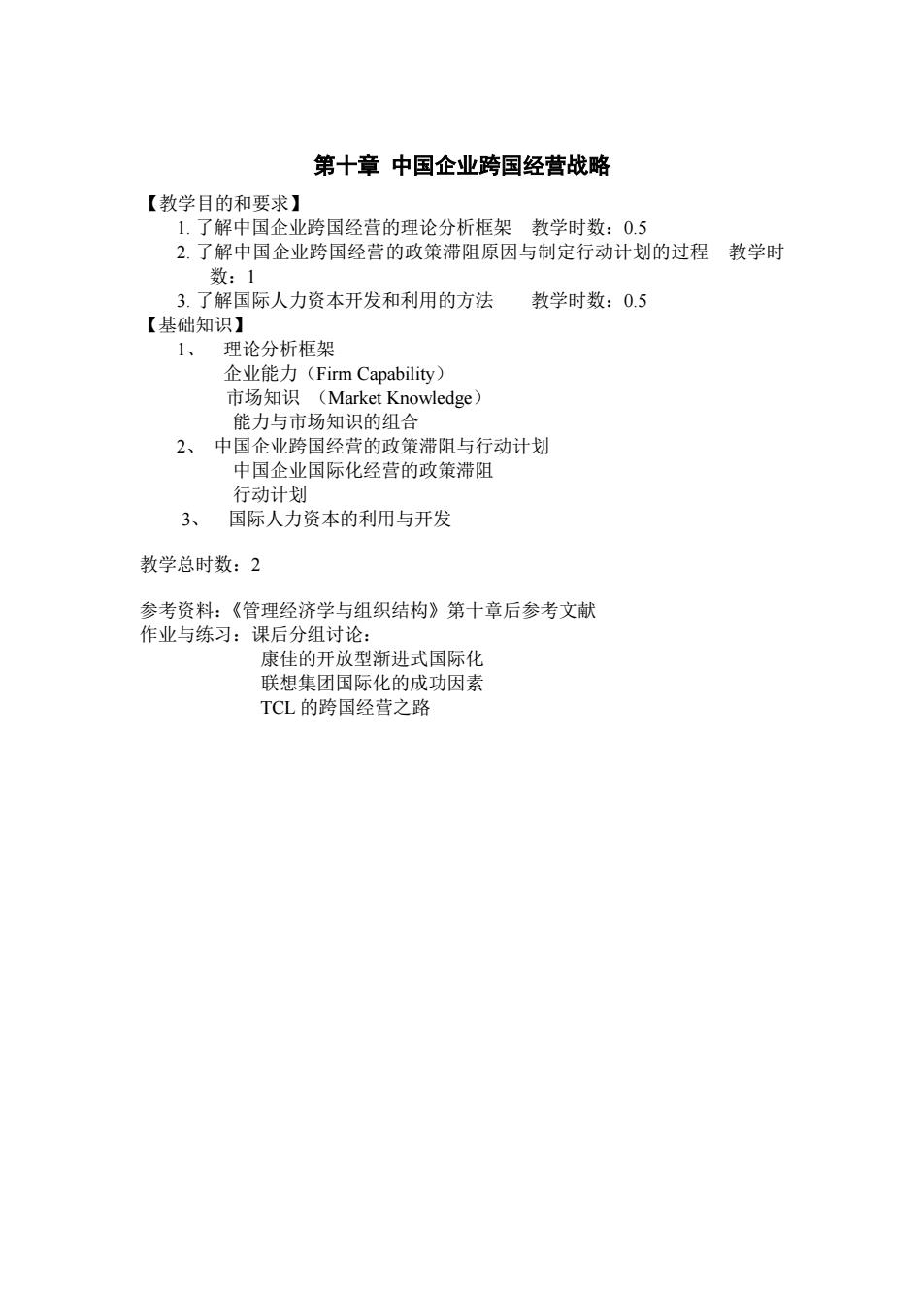
第十章中国企业跨国经营战略 【教学目的和要求】 1.了解中国企业跨国经营的理论分析框架教学时数:0.5 2.了解中国企业跨国经营的政策滞阻原因与制定行动计划的过程教学时 数:1 3.了解国际人力资本开发和利用的方法 教学时数:0.5 【基础知识】 1、 理论分析框架 企业能力(Firm Capability) 市场知识(Market Knowledge) 能力与市场知识的组合 2、中国企业跨国经营的政策滞阻与行动计划 中国企业国际化经营的政策滞阻 行动计划 3、国际人力资本的利用与开发 教学总时数:2 参考资料:《管理经济学与组织结构》第十章后参考文献 作业与练习:课后分组讨论: 康佳的开放型渐进式国际化 联想集团国际化的成功因素 TCL的跨国经营之路
第十章 中国企业跨国经营战略 【教学目的和要求】 1. 了解中国企业跨国经营的理论分析框架 教学时数:0.5 2. 了解中国企业跨国经营的政策滞阻原因与制定行动计划的过程 教学时 数:1 3. 了解国际人力资本开发和利用的方法 教学时数:0.5 【基础知识】 1、 理论分析框架 企业能力(Firm Capability) 市场知识 (Market Knowledge) 能力与市场知识的组合 2、 中国企业跨国经营的政策滞阻与行动计划 中国企业国际化经营的政策滞阻 行动计划 3、 国际人力资本的利用与开发 教学总时数:2 参考资料:《管理经济学与组织结构》第十章后参考文献 作业与练习:课后分组讨论: 康佳的开放型渐进式国际化 联想集团国际化的成功因素 TCL 的跨国经营之路